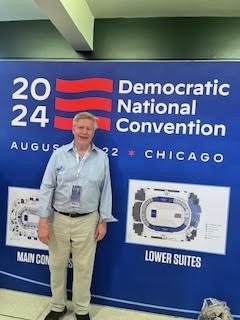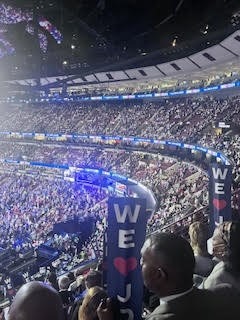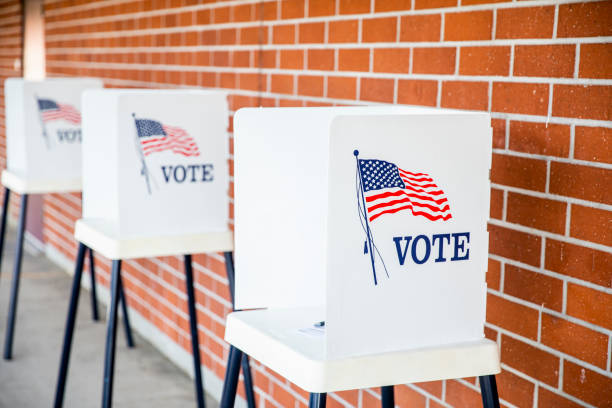An inside look from a Stratford resident on how conventions operate
Editor’s Note: Both major political parties have now wrapped up their national conventions and are getting ready for the fall campaign. James Simon, Stratford’s Democratic Registrar of Voters, attended Day One of the Democratic National Convention last week in Chicago. The Crier had plenty of questions on how it all works.

Q: Does the convention look the same on TV as it does in person?
It is far more intense – and loud – in person. There are caucus meetings and discussions of the party platform during the day, then a non-stop series of speeches and events in the evening hours when the party tries to attract media attention. It is also a reunion for delegates who try to attend every four years and see old friends from around the country.
While sitting in the convention hall Monday night, I watched some of the TV coverage on my iPhone, then compared it to what I was seeing in front of me. I laughed when one Fox commentator reported empty seats. In my area, it was literally standing room only, with people also sitting on the steps between each section. Even when President Biden was still talking at 11:30 p.m., 99% of the delegates stayed for every word.
Q: Where do all those signs come from?
There was amazing precision in the way convention leaders passed out signs – sometimes every 20 minutes – for delegates to hold and send a desired message to TV viewers at home. On Monday, I quickly went from holding a “When we fight, we win” sign … to a “USA!” sign … to “Thank you Joe” sign during President Biden’s farewell speech.
Q: What do the delegates do all day?
Some 200 Connecticut Democrats attended morning breakfasts that often featured future Democratic stars trying to get better known, like Maryland Gov. Wes Moore, as speakers. Then there are meetings and meals throughout the day, before the delegate’s assembly in the evening for speeches, votes … and the after-parties.
There is 74 actual voting delegates representing CT during the state vote.
Q: You attended the 1984 conventions – Democrats in San Francisco and Republicans in Dallas. How did this year differ?
Security! I remember a one-block perimeter, marked by a chain linked fence, around the convention halls in the 1980s. This year, six blocks around the United Center were barricaded, sometimes with Jersey barriers. You showed your credentials four times during a 10-minute walk from the first checkpoint to the hall, and I sensed we were being scanned by drones overhead during the long walk.
Media coverage is also much broader. In the press-row section of the outer hallway, traditional journalists – now joined by podcasters, content generators, and social media influencers – are conducting non-stop interviews with whatever big names they can get.
Q: How can I become a delegate at one of the 2028 conventions?
Get involved with the Democratic or Republican Party!
The parties use primary elections to determine how many convention delegates are awarded to each presidential candidate. Joe Biden swept the Connecticut primary, so he controlled the delegates. Leading Democrats like Gov. Ned Lamont, Lt. Gov. Susan Bysiewicz, U.S. Sens. Richard Blumenthal and Chris Murphy, and all five CT members of the U.S. House also attended.
In addition, the party invites alternate delegates – who get to attend all the parties and events – and guests. I asked to be a guest for the opening Monday session.
The political parties in Connecticut also hold state-level conventions in even-numbered years like 2026 to endorse candidates and rally the faithful. It is much easier to be named a delegate to those events.
Q: Who paid for all this in Chicago?
Each delegate is expected to pay their own way, and it’s costly over 4+ days. I happened to be in Chicago for a weekend wedding; the hotel jacked the price of my hotel room from $280 a night when we arrived to $450 a night during the convention.
Q: Any final thoughts?
- The Democrats always remembered it is a “made for TV” event. For example, they turned what could have been a tedious rollcall of the states into a rollicking celebration of each of the 50 states.
- Studying the crowd inside the United Center, you were constantly reminded of the importance of black women in the Democratic coalition.
- Some journalists tried to play up the potential conflict between Gaza protesters and party leaders. I watched the major protest march, and the ~1,000 people got swallowed up pretty quickly in the huge city and seemed to have zero impact.
- While I have focused on the fun and games aspect, the final goal is to get the delegates fired up and ready to work in the fall elections … and to get them comfortable with the revised ticket of Harris-Walz … and to leave TV viewers with a positive reaction to the event and to Democratic Presidential Candidate Kamala Harris.
Given the cheering, the smiles, the loudness, and the camaraderie, I think we clearly succeeded on all counts.
Editor’s Note: A response from an Gen-Z alternate delegate from Connecticut

Q. What are your impressions on being selected as an alternate delegate to the Democratic National Convention?
I don’t have a lot to say. I was an alternate delegate and I can’t think of anything that does not just restate the media coverage of the event.
Overall, it felt like they were “willing” the narrative of energy. While it was a lot of excitement at times, frankly the day started at 7 a.m. and was busy and full of waiting in lines and through speeches of the lieutenant governors until midnight every day.
Exhausting. It was nice to meet people, but it was incredibly rare to have anything but surface interactions.








